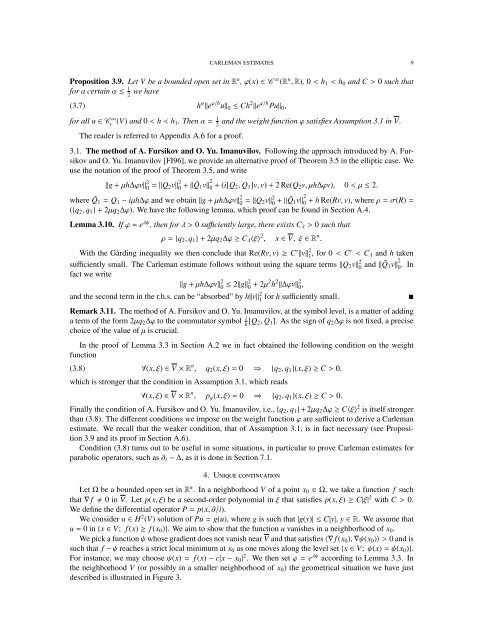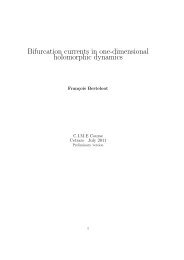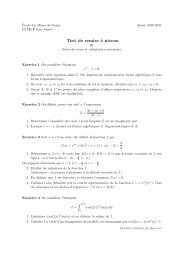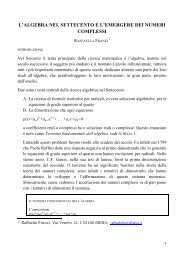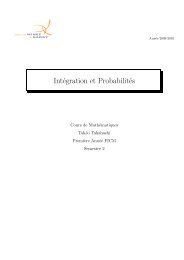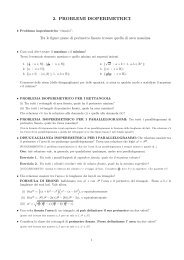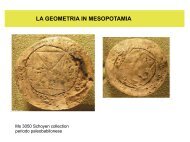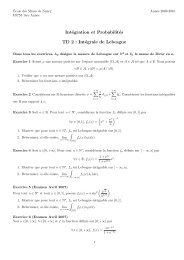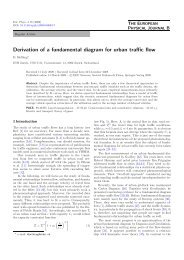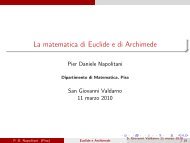on carleman estimates for elliptic and parabolic operators ...
on carleman estimates for elliptic and parabolic operators ...
on carleman estimates for elliptic and parabolic operators ...
Create successful ePaper yourself
Turn your PDF publications into a flip-book with our unique Google optimized e-Paper software.
CARLEMAN ESTIMATES 9<br />
Propositi<strong>on</strong> 3.9. Let V be a bounded open set in R n , ϕ(x) ∈ C ∞ (R n , R), 0 < h 1 < h 0 <strong>and</strong> C > 0 such that<br />
<strong>for</strong> a certain α ≤ 1 2 we have<br />
(3.7)<br />
h α ‖e ϕ/h u‖ 0 ≤ Ch 2 ‖e ϕ/h Pu‖ 0 ,<br />
<strong>for</strong> all u ∈ Cc ∞ (V) <strong>and</strong> 0 < h < h 1 . Then α = 1 2<br />
<strong>and</strong> the weight functi<strong>on</strong> ϕ satisfies Assumpti<strong>on</strong> 3.1 in V.<br />
The reader is referred to Appendix A.6 <strong>for</strong> a proof.<br />
3.1. The method of A. Fursikov <strong>and</strong> O. Yu. Imanuvilov. Following the approach introduced by A. Fursikov<br />
<strong>and</strong> O. Yu. Imanuvilov [FI96], we provide an alternative proof of Theorem 3.5 in the <strong>elliptic</strong> case. We<br />
use the notati<strong>on</strong> of the proof of Theorem 3.5, <strong>and</strong> write<br />
‖g + µh∆ϕv‖ 2 0 = ‖Q 2v‖ 2 0 + ‖ ˜Q 1 v‖ 2 0 + (i[Q 2 , Q 1 ]v, v) + 2 Re(Q 2 v, µh∆ϕv), 0 < µ ≤ 2.<br />
where ˜Q 1 = Q 1 − iµh∆ϕ <strong>and</strong> we obtain ‖g + µh∆ϕv‖ 2 0 = ‖Q 2v‖ 2 0 + ‖ ˜Q 1 v‖ 2 0 + h Re(Rv, v), where ρ = σ(R) =<br />
({q 2 , q 1 } + 2µq 2 ∆ϕ). We have the following lemma, which proof can be found in Secti<strong>on</strong> A.4.<br />
Lemma 3.10. If ϕ = e λψ , then <strong>for</strong> λ > 0 sufficiently large, there exists C λ > 0 such that<br />
ρ = {q 2 , q 1 } + 2µq 2 ∆ϕ ≥ C λ 〈ξ〉 2 , x ∈ V, ξ ∈ R n .<br />
With the Gårding inequality we then c<strong>on</strong>clude that Re(Rv, v) ≥ C ′ ‖v‖ 2 1 , <strong>for</strong> 0 < C′ < C λ <strong>and</strong> h taken<br />
sufficiently small. The Carleman estimate follows without using the square terms ‖Q 2 v‖ 2 0 <strong>and</strong> ‖ ˜Q 1 v‖ 2 0. In<br />
fact we write<br />
‖g + µh∆ϕv‖ 2 0 ≤ 2‖g‖2 0 + 2µ2 h 2 ‖∆ϕv‖ 2 0 ,<br />
<strong>and</strong> the sec<strong>on</strong>d term in the r.h.s. can be “absorbed” by h‖v‖ 2 1 <strong>for</strong> h sufficiently small.<br />
<br />
Remark 3.11. The method of A. Fursikov <strong>and</strong> O. Yu. Imanuvilov, at the symbol level, is a matter of adding<br />
a term of the <strong>for</strong>m 2µq 2 ∆ϕ to the commutator symbol i h [Q 2, Q 1 ]. As the sign of q 2 ∆ϕ is not fixed, a precise<br />
choice of the value of µ is crucial.<br />
In the proof of Lemma 3.3 in Secti<strong>on</strong> A.2 we in fact obtained the following c<strong>on</strong>diti<strong>on</strong> <strong>on</strong> the weight<br />
functi<strong>on</strong><br />
(3.8) ∀(x, ξ) ∈ V × R n , q 2 (x, ξ) = 0 ⇒ {q 2 , q 1 }(x, ξ) ≥ C > 0.<br />
which is str<strong>on</strong>ger that the c<strong>on</strong>diti<strong>on</strong> in Assumpti<strong>on</strong> 3.1, which reads<br />
∀(x, ξ) ∈ V × R n , p ϕ (x, ξ) = 0 ⇒ {q 2 , q 1 }(x, ξ) ≥ C > 0.<br />
Finally the c<strong>on</strong>diti<strong>on</strong> of A. Fursikov <strong>and</strong> O. Yu. Imanuvilov, i.e., {q 2 , q 1 } + 2µq 2 ∆ϕ ≥ C〈ξ〉 2 is itself str<strong>on</strong>ger<br />
than (3.8). The different c<strong>on</strong>diti<strong>on</strong>s we impose <strong>on</strong> the weight functi<strong>on</strong> ϕ are sufficient to derive a Carleman<br />
estimate. We recall that the weaker c<strong>on</strong>diti<strong>on</strong>, that of Assumpti<strong>on</strong> 3.1, is in fact necessary (see Propositi<strong>on</strong><br />
3.9 <strong>and</strong> its proof in Secti<strong>on</strong> A.6).<br />
C<strong>on</strong>diti<strong>on</strong> (3.8) turns out to be useful in some situati<strong>on</strong>s, in particular to prove Carleman <strong>estimates</strong> <strong>for</strong><br />
<strong>parabolic</strong> <strong>operators</strong>, such as ∂ t − ∆, as it is d<strong>on</strong>e in Secti<strong>on</strong> 7.1.<br />
4. UNIQUE CONTINUATION<br />
Let Ω be a bounded open set in R n . In a neighborhood V of a point x 0 ∈ Ω, we take a functi<strong>on</strong> f such<br />
that ∇ f 0 in V. Let p(x, ξ) be a sec<strong>on</strong>d-order polynomial in ξ that satisfies p(x, ξ) ≥ C|ξ| 2 with C > 0.<br />
We define the differential operator P = p(x, ∂/i).<br />
We c<strong>on</strong>sider u ∈ H 2 (V) soluti<strong>on</strong> of Pu = g(u), where g is such that |g(y)| ≤ C|y|, y ∈ R. We assume that<br />
u = 0 in {x ∈ V; f (x) ≥ f (x 0 )}. We aim to show that the functi<strong>on</strong> u vanishes in a neighborhood of x 0 .<br />
We pick a functi<strong>on</strong> ψ whose gradient does not vanish near V <strong>and</strong> that satisfies 〈∇ f (x 0 ), ∇ψ(x 0 )〉 > 0 <strong>and</strong> is<br />
such that f − ψ reaches a strict local minimum at x 0 as <strong>on</strong>e moves al<strong>on</strong>g the level set {x ∈ V; ψ(x) = ψ(x 0 )}.<br />
For instance, we may choose ψ(x) = f (x) − c|x − x 0 | 2 . We then set ϕ = e λψ according to Lemma 3.3. In<br />
the neighborhood V (or possibly in a smaller neighborhood of x 0 ) the geometrical situati<strong>on</strong> we have just<br />
described is illustrated in Figure 3.


